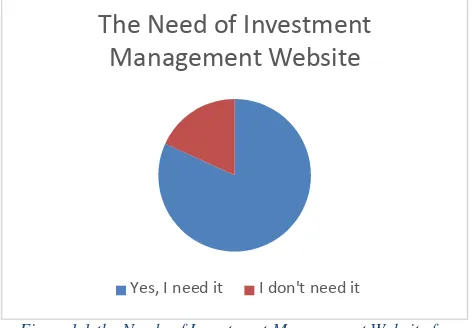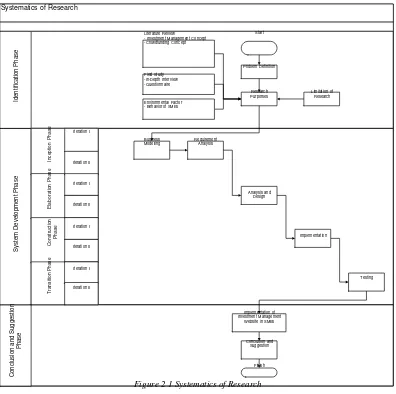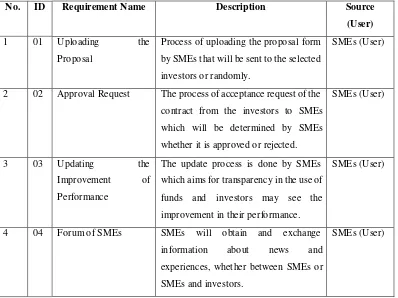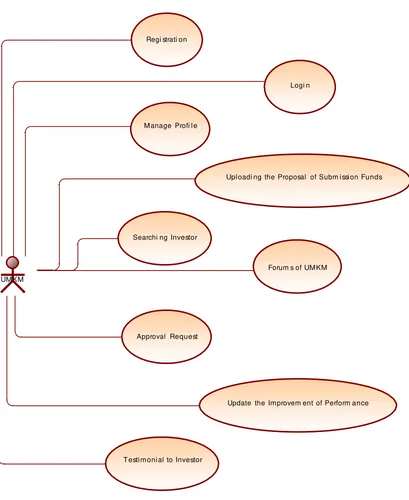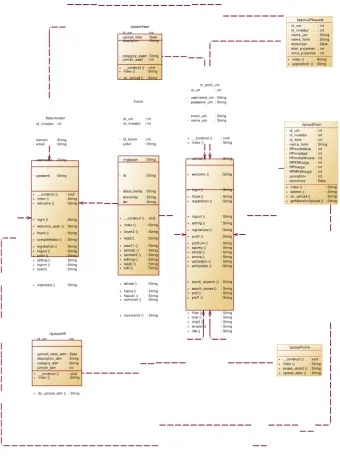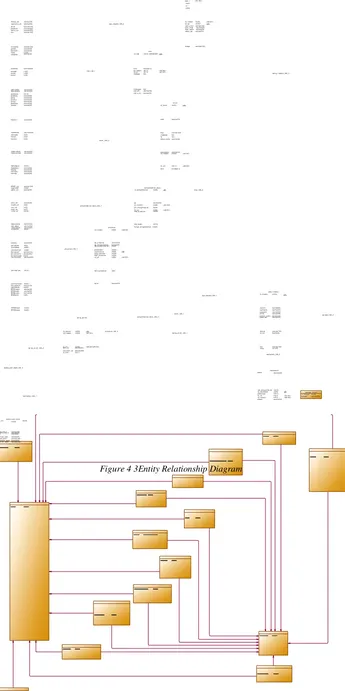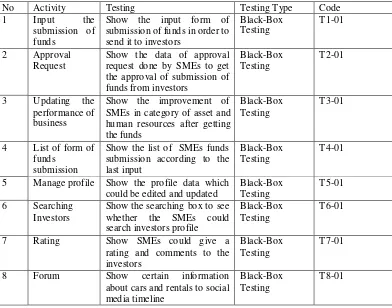DESIGN AND DEVELOPMENT OF INVESTMENT MANAGEMENT
WEBSITE BASED ON CROWDFUNDING IN SMALL AND MEDIUM-
SIZED ENTERPRISES USING ITERATIVE AND INCREMENTAL
METHOD
1Fauza Annisa, 2Nia Ambarsari, 3Taufik Nur Adi
1,3 Information System Study Program, Faculty Of Industrial and
System Engineering, Telkom University
1fauzaannisa.bis@telkomu niversity.ac.id, 2amb [email protected], 3[email protected]
Abstract
Investment is all forms of investing activity, either by domestic investors or foreign investors to obtain businesses in the territory of the Republic of Indonesia. . In the category of venture capital investment, this kind of investment is tend to be needed as capital injections for society who want to build their own business or who have set up a business but still have less availability of capital for their businesses. One of the form of business which mostly need the capital injections is Small and Medium-sized Enterprises (SMEs).
The development of an SME depends on several factors, such as the availability of capital, the use of technology to optimize production and market expansion. For capital issues, there are two main constraints often faced by SMEs. First, SMEs are having trouble in finding investors who are willing to invest in their businesses. This was due to the majority of SMEs do not have access to find and get detailed and relevant information about investors. Second, the complexity of the bureaucracy and a lot of administrative requirements that must be fulfilled if SMEs applied for a loan to the government, financial institutions, or banks. Two of these constraints inhibit SMEs in Indonesia to grow and compete with other competitors. To overcome those constraints will be built a website application of investment management based on crowdfunding using iterative and incremental method from the point of view of SMEs. The website will incorporate the investment management concept and crowdfunding model. Investment management concept will be used to regulate the procedure to be conducted by SMEs in order to obtain venture capital and how to refund to the investors. Crowdfunding model will be needed for SMEs to be able to choose and corporate with the appropriate investors because the model depends on the crowd to find and get the information and finding the solutions needed.
Keywords: Investment Management, SMEs, Crowdfunding
I. INTRODUCTION
Investment is all forms of investing activity, either by domestic investors or foreign investors to do businesses in the territory of the Republic of Indonesia. Investments are divided into various categories, such as venture capital, stocks investment, bonds, and others. In the category of venture capital investment, this kind of investment is tend to be needed as capital injections for society who want to build their own business or who have set up a business but still have less availability of capital for their businesses. One of the form of business which mostly need the capital injections is Small, and Medium-sized Enterprises (SMEs). Ministry of Cooperatives and SMEs of the Republic of Indonesia stated in February 2014 that the number of SMEs in Indonesia reached 56.5 million businesses and expected to break through 58 million businesses in the end of 2014 [1].
The development of an SME depends on several factors, such as the availability of capital, the use of technology to optimize production and market expansion. These factors can increase the competitiveness of SMEs either in terms of quality of products or to face competitors which is always growing each day. For capital issues, there are two main constraints often faced by SMEs. First, SMEs are having trouble in finding investors who are willing to invest in their businesses. This was due to the majority of SMEs do not have access to find and get detailed and relevant information about investors. Second, the complexity of the bureaucracy and a lot of administrative requirements that must be fulfilled if SMEs applied for a loan to the government, financial institutions, or banks. Two of these constraints inhibit SMEs in Indonesia to grow and compete with other compet itors.
Related to access of information, majority of Indonesia’s population use the internet to find information. It can
be utilized by SMEs to search and find the information of investors who willing to invest their money. In Indonesia, the internet users is increasing every year. Based on Ministry of Communication and Information of the Republic of Indonesia (MCIT), the internet users in Indonesia in the middle of 2014 reached until 82 million users [2]. This makes
In Indonesia, there are already several websites which became the media to provide information and fundraising for a project, such as Patungan.net, Wujudkan.com, Bangoen.com, and so on. However, most of the website solely focused on donations, not on investments. In this research has been conducted the distribution of questionnaires in order to reinforce the need for a solution in the form of a website that can facilitate SMEs in finding the investors. Based on the result of the distributions of questionnaires, respondents in terms of SMEs stated that they need a media to be able to find investors who are willing to invest in their businesses.
The Need of Investment
Management Website
Yes, I need it I don't need it
Figure1.1 the Needs of Investment Management Website for SMEs
Crowdfunding is one of the models focusing on fundraising or financing a business by utilizing the contributions of many people. This model allows SMEs to find a lot of detailed and relevant information of investors and the investors can also find a lot of information of SMEs who needs some investment. With this model for the system, SMEs have a huge opportunity to find a suitable investors for their businesses.
The research will be appointed the final project to provide facility and easiness for SMEs to be able to send their submission of funds to the investors and giving satisfaction of services through the website application in inputting and managing the investment of funds.
II. SMALL AND MEDIUM-SIZED ENTERPRISES, CROWDFUNDING, AND INVESTMENT MANAGEMENT
Micro, Small, and Medium-sized Enterprise (SMEs) is one of the most important role in national development and Indonesian economy growth. SMEs also play an important role in tackling unemployment because of the enormity of employment provided by SMEs for people who do not have jobs. Under the Law of the Republic of Indonesia Number 20 of 2008, the definition of SMEs is divided into three categories, namely micro enterprise, small enterprise, and medium enterprise [3]. In the Law of the Republic of Indonesia Number 20 of 2008 is also significantly defined the differences between Micro, Small, and Medium-sized Enterprises based on assets and turnover as below:
Table 2 1SMEs Criteria based on Turnover
Investment is a term related to finance and economics. Based on Law of the Republic of Indonesia Number 25 of 2007, investment in any form of investing activity, both by domestic investors or foreign investors to do businesses in the territory of the Republic of Indonesia [4]. It can be concluded that investment could be done in form of money or in addition of the money that expected to generate financial benefits in the future. While the parties who be able to invest referred as investor. In the Law of the Republic of Indonesia Number 25 of 2007, investor is an individual or enterprises performing an investment that can be either domestic or foreign investors.
In addition, there is a field study to manage the investment called investment management. According to Frank
J. Fabozzi in his book entitled “Capital Markets, Financial Management, and Investment Management”, Investment
C
management, such as setting investment objectives, establishing an investment policy, selecting a portfolio strategy, selecting the specific assets, and measuring and evaluating performance.
Crowdfunding, if interpreted into other terms is fundraising with the power of crowd. Crowdfunding is the
development of the concept of crowdsourcing which was first discussed Jeff Howe in 2006 in his article titled “The
Rise of Crowdsourcing” [6]. Crowdsourcing itself is a new pool of cheap labor, the expansion from outsourcing, when everyday people using their spare cycles to create content, solve problems. However, crowdsourcing is different with outsourcing. Crowdsourcing is when technological advances in everything, hobbyists, part-timers, and dabblers suddenly have a market for their efforts, as smart companies in industries as disparate as pharmaceuticals and television discover ways to tap the latent talent of the crowd, also it costs a lot less than paying traditional employees.
The term of crowdfunding has been credited to Michal Sullivan in 2006 that has defined the term through his
blog post in fundavlog. According to Michael Sullivan (2006), “Crowdfunding, inspired by crowdsourcing, describes
the collective cooperation, attention and trust by people who network and pool their money together, usually via the Internet, in order to support efforts initiated by other people or organizations. Crowdfunding occurs for any variety of
purposes, from disaster relief to citizen journalism to artists seeking support from fans, to political campaigns.”. The
goal of crowdfunding is focused on financial support in the form of raising funds for a project or business that need capital injection to support their projects or businesses that can be started or sustain properly.
III. METHODOLOGY
The iterative and incremental method is one of method often used by programmers to create a system. If the method is separated in terms of the objectives, the main objective of iterative is customer satisfaction so that focused on single needs with multiple, whereas the main objectives of incremental is requires the system to be developed incrementally, where each increments are integrated to complete the system [7].
Systematics of Research
Literature Review - Investment Management Concept -Crowdfunding Conc ept
Figure 2 1 Systematics of Research
In the system development phase, there are four phases in accordance with the method used in this research, namely iterative and incremental method. These phases are inception phase, elabo ration phase, construction phase, and transition phase. In the inception phase, will be conducted the identification of scope of the website. To identify of scope of the website will be along with the background from the perspective of SMEs that triggers t he development of the website. Moreover, in this phase is also defined the requirements needed to be featured in the website. In the elaboration phase, will be conducted the analysis and design of the basic architecture of the investment management website. In this phase also will be analyzed the risks that might arise along with the considerations and solutions. In the construction phase, will be conducted the coding process of the website based on the result of analysis and design that has been done before. The website that will be developed should be sufficient for initial testing and also in accordance with the needs and capabilities of SMEs. In the transition phase, the website that has been created and developed will be introduced to the users and the stakeholders, i.e. SMEs which will test the functionality of the system. The system is concluded as successful if users and stakeholders are satisfied with the functionality of system that run in accordance with the needs and capabilities which was defined in the inception phase.
The last phase of the systematical of research is conclusion phase. T he website that has been developed and built will be evaluated in totality to make conclusions and suggestions by the users and stakeholders which are concerned for the next development.
IV. ANALYSIS AND DESIGN
In the inception phase, will be identified the scope of the system and defined the system requirement. Identification of the scope of the website will be accompanied by the background of the problem that have been the trigger to create the system. Below is the explanation of system requirement analysis.
Table 4 1 System Requirement Analysis
No. ID Requirement Name Description Source
(User)
1 01 Uploading the
Proposal
Process of uploading the proposal form
by SMEs that will be sent to the selected
investors or randomly.
SMEs (User)
2 02 Approval Request The process of acceptance request of the
contract from the investors to SMEs
which will be determined by SMEs
whether it is approved or rejected.
SMEs (User)
3 03 Updating the
Improvement of
Performance
The update process is done by SMEs
which aims for transparency in the use of
funds and investors may see the
improvement in their performance.
SMEs (User)
4 04 Forum of SMEs SMEs will obtain and exchange
information about news and
experiences, whether between SMEs or
SMEs and investors.
SMEs (User)
Regi strati on
Logi n
M anage Profi l e
Upl oadi ng the Proposal of Subm i ssi on Funds
Searchi ng Investor
UM KM
Forum s of UM KM
Approval Request
Update the Im provem ent of Perform ance
T esti m oni al to Investor
Figure 4 1 Use Case Diagram
In the elaboration Phase, will be done the analysis and design of the basic architecture of the system. In this phase also will be analyze the risks that might arise along with the considerations and solutions. The features needed in the system has been determined and agreed by the user.
Approval Request
In the Entity Relationship Diagram, will be described the relationship between databases where the entities in the database becomes a trigger in coding process. In addition, in entity relationship diagram, will be described the attributes contained in a particular entity.
upl oads_i bfk_1
rati ng_i nvest or_i bfk_1 rati ng_i nvest or
i d_um
updat e_perf_sdm _i bfk_2 pem beri an_dana_i bfk_1
i d_dana i nt(11) i d_i nvestor i nt(11) i d_um i nt(50) <ak2, fk2>
<ak1, fk1>
V. TESTING AND IMPLEMENTATION
The construction phase and transition phase will be explained in this chapter. Construction phase is the third phase of iterative and incremental method. The documentation of every iterations will be explained. In this phase will be focusing on the implementation of the system. In the following system, will be using the client-server model and will be described in form of deployment diagram. The system is using MySQL server and Apache server to support the web application. The client will accessing the web application through web browser.
Figure 5 1Deployment Diagram
In the transition phase, testing will be done in order to check whether the features in the application running in accordance with the requirement or not. The bugs and errors will be detected in this testing session. In this research will be using black box testing in order to test the website application which tester do not have to check the code of the application. Testing plan will be done in order to test the functionality of the system. The explanation of the testing plan will be described in the table below.
Table 5 1Testing Plan
No Activity Testing Testing Type Code
1 Input the
submission of funds
Show the input form of submission of funds in order to send it to investors
Black-Box Testing
T1-01
2 Approval
Request
Show the data of approval request done by SMEs to get the approval of submission of funds from investors
Black-Box Testing
T2-01
3 Updating the
performance of business
Show the improvement of SMEs in category of asset and human resources after getting the funds
Black-Box Testing
T3-01
4 List of form of
funds submission
Show the list of SMEs funds submission according to the last input
Black-Box Testing
T4-01
5 Manage profile Show the profile data which
could be edited and updated
Black-Box Testing
T5-01
6 Searching
Investors
Show the searching box to see whether the SMEs could search investors profile
Black-Box Testing
T6-01
7 Rating Show SMEs could give a
rating and comments to the investors
Black-Box Testing
T7-01
8 Forum Show certain information
about cars and rentals to social media timeline
Black-Box Testing
VI. CONCLUSION
Conclusion for this research are as follows:
1) The investment management website is created successfully in order to apply the concept of crowdfunding for SMEs in distributing form of submission funds. The website is also provides detailed information related to investors who also the members of the website.
2) The investment management website has been developed using iterative and incremental method. This website has been adjusted to the needs of SMEs and also giving appropriate information so as to facilitate SMEs in using and exploring the website.
3) Based on the feedback that has been obtained and processed, the investment management website is successfully providing convenience for SMEs to seek submission of funds from investors. By using the concept of investment management for the development of the website has created transparency and trust form SMEs to use the website.
REFERENCES
[1] Kementrian Koperasi dan UKM Republik Indonesia. (2010, October 29). Retrieved from Kementrian Koperasi dan
UKM Republik Indonesia: http://www.depkop.go.id
[2] Kementrian Komunikasi dan Informasi Republik Indonesia. (2014, October 29). Retrieved from Kementrian
Komunikasi dan Informasi Republik Indonesia: http://www.kominfo.go.id
[3] DEWAN PERWAKILAN RAKYAT REPUBLIK INDONESIA dan PRESIDEN REPUBLIK INDONESIA. (n.d.).
Undang- Undang Nomor 20 Tahun 2008 tentang Usaha Mikro, Kecil dan Menengah (UMKM).
[4] DEWAN PERWAKILAN RAKYAT REPUBLIK INDONESIA dan PRESIDEN REPUBLIK INDONESIA. (n.d.).
Undang Undang Republik Indonesia Nomor 25 Tahun 2007 Tentang Penanaman Modal.
[5] Fabozzi, F., & Drake, P. (2009). Finance: Capital Markets, Financial Management, and Investment Management.
pp577-582.
[6] 5.
[7] Howe, J. (2009). Crowdsourcing: Why the Power of Crowd is Driving the Future of Business. pp280-283.
